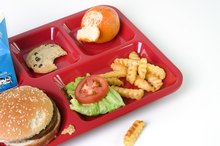What does fact checked mean?
At Healthfully, we strive to deliver objective content that is accurate and up-to-date. Our team periodically reviews articles in order to ensure content quality. The sources cited below consist of evidence from peer-reviewed journals, prominent medical organizations, academic associations, and government data.
The information contained on this site is for informational purposes only, and should not be used as a substitute for the advice of a professional health care provider. Please check with the appropriate physician regarding health questions and concerns. Although we strive to deliver accurate and up-to-date information, no guarantee to that effect is made.
School lunches are experiencing an overhaul due to the 2010 Child Nutrition Bill, because school lunches have been linked to obesity, according to the U.S. Federal Government. This is due to the drastic rise in overweight and obese children in America 1. Many parents feed their children junk food before and after kids attend schools, which adds onto the obesity issue. Unfortunately, children have minimal education and decision making ability on their diet, since they have to eat what is dished to them.
Food Quality Before the 2010 Child Nutrition Bill
Before 2010, school lunches were as unhealthy or more unhealthy than fast food. National Public Radio reports that school lunch food are rejected by fast food giants like Kentucky Fried Chicken, because of the food's quality. USA Today explains that old hens that are no longer able to produce eggs and are of questionable quality are sold as meat for pet food, compost and school lunches.
Food Nutrition Before the 2010 Child Nutrition Bill
What Are the Benefits of Healthy School Lunches?
Learn More
Fast food and school lunches are similar in the amount of fat and calories they contain. They both contain saturated fat, which leads to hypertension, heart disease and stroke. However, fast food contains trans fat, also called partially hydrogenated fat, which is an artificial saturated fat and the National Cancer Institute states that it causes heart disease 2. Both school lunches and fast food are high in refined breads and pastas, which is linked to obesity and diabetes, plus they do not contain dietary fiber, which is essential to digestive health, according to Iowa State University Extension.
- Fast food and school lunches are similar in the amount of fat and calories they contain.
- However, fast food contains trans fat, also called partially hydrogenated fat, which is an artificial saturated fat and the National Cancer Institute states that it causes heart disease 2.
Food Quality After the 2010 Child Nutrition Bill
Schools were given a funding increase to improve the quality of the school food. Fast food and junk food are being removed from many school cafeterias and vending machines so that children are left with more healthful options.
Nutrition Education
Diseases From Eating Unhealthy School Lunches
Learn More
School lunches are transitioning to healthier food options over fast food. Thanks to television educational programs like “America's Food Revolution,” Margo Wootan, First Lady Michelle Obama and the U.S. Congress, the public is more aware of how children’s health is at risk and what can resolve the obesity epidemic. Schools now teach students about health education with educational programs.
- School lunches are transitioning to healthier food options over fast food.
- Thanks to television educational programs like “America's Food Revolution,” Margo Wootan, First Lady Michelle Obama and the U.S. Congress, the public is more aware of how children’s health is at risk and what can resolve the obesity epidemic.
Related Articles
References
Writer Bio
Diana Gamble's health-oriented articles have been published in magazines such as "The Natural Journal" since 2007. She earned certifications for massage therapy and nutritional consulting from the North Carolina School of Holistic Medicine. She graduated from the University of North Carolina-Asheville with a Bachelor of Arts in literature.









